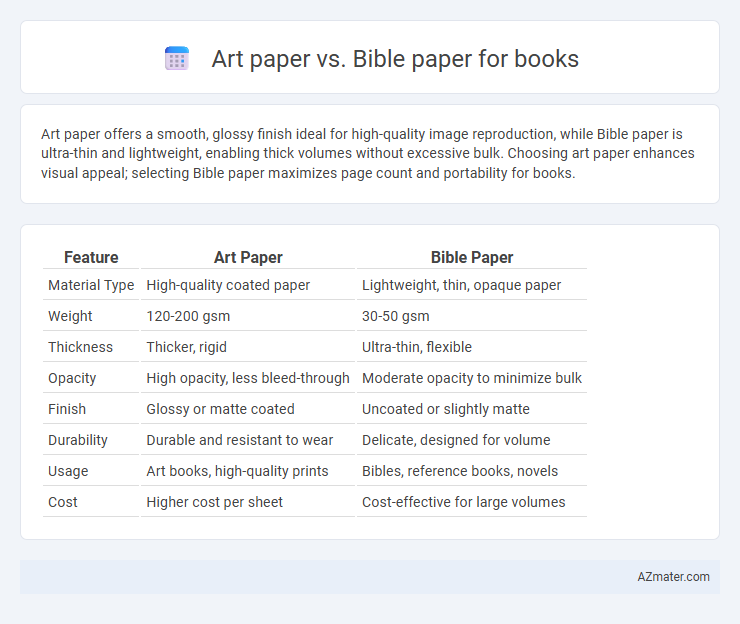Art paper offers a smooth, glossy finish ideal for high-quality image reproduction, while Bible paper is ultra-thin and lightweight, enabling thick volumes without excessive bulk. Choosing art paper enhances visual appeal; selecting Bible paper maximizes page count and portability for books.
Table of Comparison
| Feature | Art Paper | Bible Paper |
|---|---|---|
| Material Type | High-quality coated paper | Lightweight, thin, opaque paper |
| Weight | 120-200 gsm | 30-50 gsm |
| Thickness | Thicker, rigid | Ultra-thin, flexible |
| Opacity | High opacity, less bleed-through | Moderate opacity to minimize bulk |
| Finish | Glossy or matte coated | Uncoated or slightly matte |
| Durability | Durable and resistant to wear | Delicate, designed for volume |
| Usage | Art books, high-quality prints | Bibles, reference books, novels |
| Cost | Higher cost per sheet | Cost-effective for large volumes |
Introduction to Art Paper and Bible Paper
Art paper generally features a smooth, bright, and high-quality finish designed to enhance the vibrancy and detail of printed images, making it ideal for photo books and art catalogs. Bible paper, also known as lightweight, thin, and opaque paper, is specifically engineered to be durable and thin enough to allow thousands of pages in a single volume without adding excessive bulk. Both paper types serve distinct purposes: art paper prioritizes visual quality and texture, while Bible paper focuses on density and readability for extensive textual content.
Material Composition and Properties
Art paper consists primarily of high-quality wood pulp with added fillers like calcium carbonate, resulting in a smooth, glossy surface ideal for vibrant image reproduction and high ink absorption. Bible paper, often called India paper, uses a blend of high-quality cotton or linen fibers combined with wood pulp and special sizing agents, creating extremely thin, opaque, and durable sheets to maximize page count without sacrificing legibility. The superior tensile strength and opacity of Bible paper prevent bleed-through, whereas art paper prioritizes brightness and color brilliance suited for art books and magazines.
Thickness and Weight Differences
Art paper typically features a thicker and heavier composition, often ranging from 120 to 300 gsm, providing durability and a premium feel ideal for high-quality prints and detailed images. Bible paper is much thinner and lighter, usually between 30 to 50 gsm, designed to be lightweight and thin enough to keep large books compact without sacrificing opacity. These thickness and weight differences influence the overall bulk, flexibility, and tactile experience of books printed on each type of paper.
Print Quality and Ink Absorption
Art paper offers superior print quality with vibrant colors and sharp image details, ideal for high-end photo books and art reproductions. Bible paper, known for its thin and lightweight properties, absorbs ink differently, often resulting in slight bleed-through but enabling a more compact book thickness. The choice between art paper and Bible paper significantly impacts print clarity and ink absorption, with art paper providing a premium finish and Bible paper favoring durability and size efficiency.
Opacity and Show-Through
Art paper offers high opacity, minimizing show-through and providing crisp, vibrant image printing with sharp details in books. Bible paper, while thinner and lighter for compact book formats, has lower opacity, which can result in noticeable show-through on double-sided pages. Selecting art paper enhances readability and visual quality by reducing transparency, essential for image-heavy or premium books.
Durability and Longevity
Art paper offers superior durability compared to Bible paper due to its thicker weight and higher GSM (grams per square meter), providing enhanced resistance to wear and tear over time. Bible paper, typically thinner with a lower GSM, is designed for compactness and lightweight books but is more prone to yellowing, tearing, and brittleness, impacting its longevity. For books requiring extended life and frequent handling, art paper stands out as the more resilient and long-lasting choice.
Suitability for Illustrations and Photography
Art paper offers a smooth, glossy finish with high brightness and excellent ink absorption, making it ideal for vibrant illustrations and high-resolution photography in books. Bible paper, characterized by its thin, lightweight, and slightly opaque nature, is less suitable for detailed images as it tends to cause show-through and less color vibrancy. Choosing art paper enhances the visual impact of photo-centric or illustration-heavy publications, while Bible paper is more commonly used for text-dense books requiring compactness and durability.
Cost Comparison
Art paper typically costs 20% to 40% more than Bible paper due to its heavier weight and higher brightness level, making it ideal for image-heavy books like art catalogs. Bible paper is thinner and lighter, reducing material and shipping costs, which is why publishers often choose it for large, text-dense books such as bibles and reference materials. Choosing Bible paper can lower overall production expenses by up to 30%, benefiting projects with tight budgets or large print runs.
Environmental Impact and Sustainability
Art paper typically requires more resources, including water and energy, during production and often involves chemical treatments that can increase its environmental footprint compared to Bible paper. Bible paper is thinner and uses less raw material per sheet, contributing to reduced deforestation and lower carbon emissions, making it a more sustainable choice for book manufacturing. Choosing Bible paper supports eco-friendly publishing practices due to its minimal resource consumption and lighter transportation impact.
Choosing the Right Paper for Your Book
Art paper offers a smooth, high-quality finish ideal for vibrant, detailed images and color-rich illustrations, making it perfect for art books, photography collections, or premium editions. Bible paper is ultra-thin, lightweight, and durable, designed to reduce bulk while maintaining opacity, which suits thick volumes like dictionaries, Bibles, or reference books. Selecting the right paper depends on balancing visual impact, book thickness, weight, and intended use to ensure the final product meets both aesthetic and functional needs.

Infographic: Art paper vs Bible paper for Book
 azmater.com
azmater.com